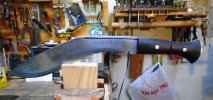Ask and ye shall receive.
From Wikipedia:
Gluten (from Latin
gluten, "glue") is a group of
proteins, called
prolamins and
glutelins,
[1] which occur with
starch in the
endosperm of various
cereal grains. This
protein complex supplies 75–85% of the total protein in bread
wheat.
[2][3] It is found in related wheat species and hybrids, (such as
spelt,
khorasan,
emmer,
einkorn, and
triticale),
barley,
rye, and
oats,
[4] as well as products derived from these grains, such as
breads and
malts.
Glutens, especially
Triticeae glutens, have unique
viscoelastic and
adhesive properties, which give
dough its elasticity, helping it
rise and keep its shape and often leaving the final product with a chewy texture.
[2][5][6] These properties and its relative low cost are the reasons why gluten is so widely demanded by the food industry and for non-food uses.
[6]
Prolamins in wheat are called
gliadins; in barley,
hordeins; in rye,
secalins; and in oats,
avenins. These protein classes are collectively referred to as gluten.
[4] Wheat
glutelins are called
glutenin.
[7] True gluten is limited to these four grains.
[1] (The storage proteins in
maize and
rice are sometimes called glutens, but they differ from true gluten.
[1])
 Bread produced from wheat grains contains gluten
Bread produced from wheat grains contains gluten
Gluten can trigger adverse
inflammatory,
immunological and
autoimmune reactions in some people. Gluten can produce a broad spectrum of
gluten-related disorders, including
coeliac disease in 1–2% of the general population,
non-coeliac gluten sensitivity in 6–10% of the general population,
dermatitis herpetiformis,
gluten ataxia and other
neurological disorders.
[8][9][10][11] These disorders are treated by a
gluten-free diet.
[11]




